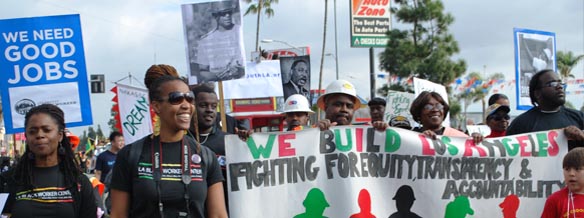
(Photo credit: LA Black Workers Center)
Workplace discrimination. It often confronts African-Americans and Latinos but is increasingly difficulty to evidence and even more difficult to challenge through legal channels. Victims know it when it occurs but the manner in which they experience it is less overt at times and more under the radar. Implicit bias is more prevalent in the workplace today than forms of discrimination that can be detected by patterns or identifiable incidents. It is why many Blacks and Latinos who experience discrimination often suffer in silence, get frustrated in fighting conditions in the workplace and leave, or are dismissed unfairly and feel as though they have no legal recourse.
What is vexing about conditions in the workplace today is that it is often college-educated employees who complain the most about maltreatment in white collar professions. These are the same African-American and Latino professionals who believed they followed the ‘rules of the game’ and pursued higher education, worked their way into their positions, adhered to cultural norms and still found themselves denied opportunities on the basis of their race or ethnicity.
A recent report from Race Forward – The Center for Racial Justice and Innovation, titled Confronting Racial Bias at Work, seeks to describe the challenges in the 21st Century workplace and offer solutions to combat discriminatory practices. The first part of the report provides an overview of the history of the federal Equal Employment Opportunity Commission (EEOC). The agency was created in the 1960s under Title VII of the Civil Rights Act of 1964 to help combat intentional discrimination in the workplace. These incidents could be failure to hire a qualified candidate on the basis of his or her race, the denial of a promotion on the basis of race, or hostility toward an employee that is rooted in racism. While the EEOC was a significant step forward to address employment discrimination, the agency has never been equipped or legislatively authorized to combat systemic discrimination in the labor market.
The second part of Confronting Racial Bias at Work focuses on barriers within the legal and administrative system established to fight discrimination. Barriers such as the inability to hire legal counsel, forced arbitration and skeptical judges are identified as challenges individuals face when trying to bring a discrimination claim through the courts. The report notes “Courts have made it increasingly difficult for workers to be certified as a class, and to challenge discriminatory outcomes unless they can point to a single employment practice as a culprit.”
Part Three of the report profiles three recent campaigns by worker organizations that have essentially worked outside of the established legal and administrative systems under Title VII to combat employment discrimination. The LA Black Workers Center has staged a campaign to secure project labor agreements for underrepresented workers in the construction industry. In New York City, the Laundry Workers Center trained and helped unionize retail and warehouse workers to improve working conditions. The National Domestic Workers Alliance in Massachusetts scored a victory with the passage of a Domestic Workers Bill of Rights that improves working conditions in an industry where women of color are overrepresented.
The last section of the report, Part Four, presents several systemic solutions and recommendations to secure “fairness and equitable outcomes” for workers of color. They include:
Equity pressures to boost workers and consumer power to advance the voluntary compliance of employers and industries.
Equity incentives to make it more advantageous for businesses to support racial equity.
Equity mandates that legally require the best equitable employment practices of employers.
Read the full report Confronting Racial Bias at Work to get a better understanding of some of the significant challenges in fighting discrimination in the workplace.

today in black history
July 27, 2023
Audley "Queen Mother" Moore, one of the first activists to demand reparations for slavery, was born in 1898 in New Iberia, Louisiana.
Policy Spotlight: Workplace Discrimination
POSTED: December 12, 2016, 7:00 am
























